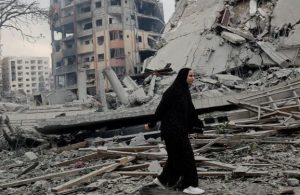Hidden cost of conflicts: women’s rights abuses during war
Opinion
By Katerina Hatzi
Human rights advocacy group Global Citizen reports that “women in conflict zones are 7.7 times more likely to experience extreme poverty.”
The female experience during conflicts often involves much suffering, from experiencing gender violence to not having access to proper sanitary products and health services, as well as education.
Sudden changes in political and social structures in many countries can create an uncertain future for female citizens.
Syria has faced an incredible turn of events in its rule of power as the Assad regime came to an end when Hayat Tahrir al-Sham (HTS), a Sunni Islamist coalition formed in 2017, became the main political force through a coup d’état.
While a large part of the country’s population has rejoiced and accepted this change, it is worth for the rest of us to reflect on how the women in Syria have suffered during conflicts in the past and what the future holds for them.
It is true that the Assad regime had been labelled by many as tyrannical but, as mentioned by Newsweek, the situation in Syria is a “moment of risk and uncertainty”, as HTS has a record of “terrorism and human rights abuses.”
So, what does this mean for Syrian women?
For 13 years, the country had been fractured by a civil war, which saw many being incarcerated, tortured, and killed.
The HTS that took over on November 30 has a questionable past.
The military group’s leader, Abu Mohammad al-Jolani, once had ties with both ISIS and al Qaeda.
He has now cut ties with both groups and has a sole focus on Syria and to form a “council chosen by the people”, as CNN reports.
 While this may sound optimistic, it is reminiscent of the Taliban’s actions in 2021 where, while their rhetoric at the time seemed progressive and promising, they quickly enforced Sharia law, which has, since, had a devastating impact on the lives of women and girls in Afghanistan.
While this may sound optimistic, it is reminiscent of the Taliban’s actions in 2021 where, while their rhetoric at the time seemed progressive and promising, they quickly enforced Sharia law, which has, since, had a devastating impact on the lives of women and girls in Afghanistan.
We can only hope that the same does not happen in Syria.
Throughout the years of the civil war, thousands of girls had been denied the right to food and health, as the United Nations mentions. As a result, 74 per cent of women and girls had been in dire need of nutritional assistance.
While the Assad regime was still in power, there had been a number of practices that were found to be in violation of basic human rights by international human rights bodies.
Even worse, up until the coup d’état, there had been early and forced marriages, as the United Nations reports, as a consequence of the years long conflict.
Access to housing and property had also been particularly difficult for women.
In addition, the conflict saw a rise in sexual violence against women, with many instances of rape.
Such facts suggest that life under the Assad regime was nothing less but terrifying for Syrian women.
And yet, the question remains; will the HTS keep its promise and give the power to the people by adapting democratic processes?
Or will this be yet another dead end to women’s rights in Syria?












